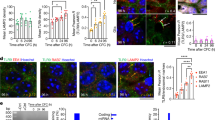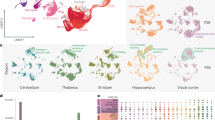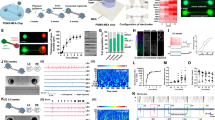Abstract
Several genes essential for neocortical layering have been identified in recent years, but their precise roles in this process remain to be elucidated. Mice deficient in p35—an activator of cyclin-dependent kinase 5 (Cdk5)—are characterized by a neocortex that has inverted layering. To decipher the physiological mechanisms that underlie this defect, we compared time-lapse recordings between p35−/− and wild-type cortical slices. In the p35−/− neocortex, the classic modes of radial migration—somal translocation and locomotion—were largely replaced by a distinct mode of migration: branched migration. Branched migration is cell-autonomous, associated with impaired neuronal-glial interaction and rare in neurons of scrambler mice, which are deficient in Dab1. Hence, our findings suggest that inside-out layering requires distinct functions of Reelin and p35/Cdk5 signaling, with the latter being important for proper glia-guided migration.
This is a preview of subscription content, access via your institution
Access options
Subscribe to this journal
Receive 12 print issues and online access
$209.00 per year
only $17.42 per issue
Buy this article
- Purchase on Springer Link
- Instant access to full article PDF
Prices may be subject to local taxes which are calculated during checkout





Similar content being viewed by others
References
Angevine, J. Jr. & Sidman, R.L. Autoradiographic study of cell migration during histogenesis of cerebral cortex in the mouse. Nature 192, 766–768 (1961).
Rakic, P. Neuron-glia relationship during granule cell migration in developing cerebellar cortex. A Golgi and electron microscopic study in Macacus Rhesus. J. Comp. Neurol. 141, 283–312 (1971a).
Rakic, P. Guidance of neurons migrating to the fetal monkey neocortex. Brain Res. 33, 471–476 (1971b).
Rakic, P. Mode of cell migration to the superficial layers of fetal monkey neocoretex. J. Comp. Neurol. 145, 61–83 (1972).
O'Rourke, N.A., Dailey, M.E., Smith, S.J. & McConnell, S.K. Diverse migratory pathways in the developing cerebral cortex. Science 258, 299–302 (1992).
Edmondson, J.C. & Hatten, M.E. Glial-guided granule neuron migration in vitro: a high resolution time-lapse video microscopic study. J. Neurosci. 7, 1928–1934 (1987).
Pearlman, A.L., Faust, P.L., Hatten, M.E. & Brunstrom, J.E. New directions for neuronal migration. Curr. Opin. Neurobiol. 8, 45–54 (1998).
Morest, D.K. A study of neurogenesis in the forebrain of opossum pouch young. Z. Anat. Entwicklungsgesch. 130, 265–305 (1970).
Book, K.J. & Morest, D.K. Migration of neuroblasts by perikaryal translocation: role of cellular elongation and axonal outgrowth in the acoustic nuclei of the chick embryo medulla. J. Comp. Neurol. 297, 55–76 (1990).
Book, K.J., Howard, R. & Morest, D.K. Direct observation in vitro of how neuroblasts migrate: medulla and cochleovestibular ganglion of the chick embryo. Exp. Neurol. 111, 228–243 (1991).
Hendriks, R., Morest, D.K. & Kaczmarek, L.K. Role in neuronal cell migration for high-threshold potassium currents in the chicken hindbrain. J. Neurosci. Res. 58, 805–814 (1999).
Hager, G., Dodt, H.-U., Sieglgansberger, W. & Liesi, P. Novel forms of neuronal migration in the rat cerebellum. J. Neurosci. Res. 40, 207–219 (1995).
Yee, K.T., Simon, H.H., Tessier-Lavigne, M. & O'Leary, D.M. Extension of long leading processes and neuronal migration in the mammalian brain directed by the chemoattractant netrin-1. Neuron 24, 607–622 (1999).
Gray, G.E. & Sanes, J.R. Migratory paths and phenotypic choices of clonally related cells in the avian optic tectum. Neuron 6, 211–225 (1991).
Snow, R.L. & Robson, J.A. Migration and differentiation of neurons in the retina and optic tectum of the chick. Exp. Neurol. 134, 13–24 (1995).
Brittis, P.A., Meiri, K., Dent, E. & Silver, J. The earliest pattern of neuronal differentiation and migration in the mammalian central nervous system. Exp. Neurol. 133, 1–12 (1995).
Nadarajah, B., Brunstrom, J.E., Grutzendler, J., Wong, R.O.L. & Pearlman, A.L. Two modes of radial migration in early development of the cerebral cortex. Nat. Neurosci. 4, 143–150 (2001).
Miyata, T., Kawaguchi, A., Okano, H. & Ogawa, M. Asymmetric inheritance of radial glial fibers by cortical neurons. Neuron 31, 727–741 (2001).
Cooper, J.A. & Howell, B.W. Lipoprotein receptors: signaling functions in the brain? Cell 97, 671–674 (1999).
Bar, I., Lambert de Rouvroit, C. & Goffinet, A.M. The evolution of cortical development. An hypothesis based on the role of the Reelin signaling pathway. Trends Neurosci. 23, 633–638 (2000).
Rice, D.S. & Curran, T. Role of the reelin signaling pathway in central nervous system development. Annu. Rev. Neurosci. 24, 1005–1039 (2001).
Herz, J. The LDL receptor gene family: (un)expected signal transducers in the brain. Neuron 29, 571–581 (2001).
Gilmore, E.C. & Herrup, K. Cortical development: receiving reelin. Curr. Biol. 10, R162–166 (2000).
Gupta, A., Tsai, L.H. & Wynshaw-Boris, A. Life is a journey: a genetic look at neocortical development. Nat. Rev. Genet. 3, 342–355 (2002).
Feng, Y. & Walsh, C. Protein-protein interactions, cytoskeletal regulation and neuronal migration. Nat. Rev. Neurosci. 2, 408–416 (2001).
Chae, T. et al. Mice lacking p35, a neuronal specific activator of Cdk5, display cortical lamination defects, seizures, and adult lethality. Neuron 18, 29–42 (1997).
Kwon, Y.T. & Tsai, L.H. A novel disruption of cortical development in p35(−/−) mice distinct from reeler. J. Comp. Neurol. 395, 510–522 (1998).
Ohshima, T. et al. Targeted disruption of the cyclin-dependent kinase 5 gene results in abnormal coticogenesis, neuronal pathology and perinatal death. Proc. Natl. Acad. Sci. USA 93, 11173–11178 (1996).
Gilmore, E.C., Ohshima, T., Goffinet, A.M., Kulkarni, A.B. & Herrup, K. Cyclin-dependent kinase 5-deficient mice demonstrate novel developmental arrest in cerebral cortex. J. Neurosci. 18, 6370–6377 (1998).
Gilmore, E.C. & Herrup, K. Neocortical cell migration: GABAergic neurons and cells in layers I and VI move in a cyclin-dependent kinase 5-independent manner. J. Neurosci. 21, 9690–9700 (2001).
Nikolic, M., Dudek, H., Kwon, Y.T., Ramos, Y.F. & Tsai, L.H. The cdk5/p35 kinase is essential for neurite outgrowth during neuronal differentiation. Genes Dev. 10, 816–825 (1996).
Nikolic, M., Chou, M.M., Lu, W., Mayer, B.J. & Tsai, L.H. The p35/Cdk5 kinase is a neuron-specific Rac effector that inhibits Pak1 activity. Nature 395, 194–198 (1998).
Kwon, Y.T., Gupta, A., Zhou, Y., Nikolic, M. & Tsai, L.H. Regulation of N-cadherin-mediated adhesion by the p35-Cdk5 kinase. Curr. Biol. 10, 363–372 (2000).
Niethammer, M. et al. NUDEL is a novel Cdk5 substrate that associates with LIS1 and cytoplasmic dynein. Neuron 28, 697–711 (2000).
Sasaki, S. et al. A LIS1/NUDEL/cytoplasmic dynein heavy chain complex in the developing and adult central nervous system. Neuron 28, 681–696 (2000).
Noctor, S.C., Flint, A.C., Weissman, T.A., Dammerman, R.S. & Kriegstein A.R. Neurons derived from radial glial cells establish radial units in neocortex. Nature 409, 714–720 (2001).
Walsh, C. & Cepko, C.L. Clonally related cortical cells show several migration patterns. Science 241, 1342–1345 (1988).
Luskin, M.B., Pearlman, A.L. & Sanes, J.R. Cell lineage in the cerebral cortex of the mouse studied in vivo and in vitro with a recombinant retrovirus. Neuron 1, 635 (1988).
Tabata, H. & Nakajima, K. Efficient in utero gene transfer system to the developing mouse brain using electroporation: visualization of neuronal migration in the developing cortex. Neuroscience 103, 865–872 (2001).
D'Arcangelo, G. et al. A protein related to extracellular matrix proteins deleted in the mouse mutant reeler. Nature 374, 719–723 (1995).
D'Arcangelo, G. et al. Reelin is a ligand for lipoprotein receptors. Neuron 24, 471–479 (1999).
Hiesberger, T. et al. Direct binding of Reelin to VLDL receptor and ApoE receptor 2 induces tyrosine phosphorylation of disabled-1 and modulates tau phosphorylation. Neuron 24, 481–489 (1999).
Howell, B.W., Hawkes, R., Soriano, P. & Cooper, J.A. Neuronal position in the developing brain is regulated by mouse disabled-1. Nature 389, 733–737 (1997).
Trommsdorff, M. et al. Reeler/Disabled-like disruption of neuronal migration in knockout mice lacking the VLDL receptor and ApoE receptor 2. Cell 97, 689–701 (1999).
Sheldon, M. et al. Scrambler and yotari disrupt the disabled gene and produce a reeler-like phenotype in mice. Nature 389, 730–733 (1997).
Ware, M.L. et al. Aberrant splicing of a mouse disabled homolog, mdab1, in the scrambler mouse. Neuron 19, 239–249 (1997).
Nadarajah, B., Alifragis, P., Wong, R.O. & Parnavelas, J.G. Ventricle-directed migration in the developing cerebral cortex. Nat. Neurosci. 5, 218–224 (2002).
Pinto-Lord, M.C., Evrard, P. & Caviness, V.S. Jr. Obstructed neuronal migration along radial glial fibers in the neocortex of the reeler mouse: a Golgi-EM analysis. Brain Res. 256, 379–393 (1982).
Keshvara, L., Magdaleno, S., Benhayon, D. & Curran, T. Cyclin-dependent kinase 5 phosphorylates disabled 1 independently of Reelin signaling. J. Neurosci. 22, 4869–4877 (2002).
Beffert, U. et al. Reelin-mediated signaling locally regulates PKB/Akt and GSK-3β. J. Biol. Chem. 277, 49958–49964 (2002).
Acknowledgements
The authors thank S. Tobet at the Shriver Center for technical help with the slice procedure, F. Gertler at Massachusetts Institute of Technology, where the quantitative and trajectory analysis was performed with DIAS software, and H. Patzke, M.D. Nguyen, J. Ko and B. Samuels for comments on the manuscript. K.S. is supported by a fellowship from the Naito Foundation. This work was supported by National Institutes of Health grants to L-H.T. and by research grants from the National Eye Institute (EY00621 to A.L.P.). L.-H.T. is an associate investigator of the Howard Hughes Medical Institute.
Author information
Authors and Affiliations
Corresponding author
Ethics declarations
Competing interests
The authors declare no competing financial interests.
Supplementary information
Supplementary Fig. 1.
(a) Examples of branched p35 deficient neurons selected from the videomicroscopic data. Branch points and branches are designated by thick and thin arrows, respectively. White and blue colors indicate two separate branching cells in the same mage field. (b) Examples of branched neurons, compiled from p35 deficient neocortices that were infected with a GFP-carrying retrovirus at E12 and subjected to GFP-immunohistochemistry 3 days later. (JPG 37 kb)
Supplementary Fig. 2.
(a) Quantification of dynamic branching of a resting p35-/- neuron with complex branching morphology. (Top) Depicted is a resting neuron at two different time points (left, right) that shows dynamic changes of its branching morphology over time. The branching morphology consists of a main branch point (white arrows), a left branch (blue arrows), a right main branch (red arrows, left: growth cone is outlined) and a smaller right side branch (asterisk), which creates a side branch point. (Bottom) For the depicted neuron, the length of the branches (in μm) and the angles of the branch points (in degrees) are plotted against time (in hours). The dynamic nature of branching is evident not only in the changes of branch lengths, but also in the changes of the main branch point angle. (b) Quantification of dynamic branching of a resting p35-/- neuron with simple branching morphology. This neuron possesses a branching morphology that comprises of one branch point from which a left and right branch extend. The lengths of the branches (in μm) and the angle of the branch point (in degrees) are plotted against time (in hours). In this case, the dynamic changes in branching can be followed from branch point formation to branch point termination. Somal movement commences only after a second branch point is established at farther distance. (c) Dynamic branching of a p35-/- neuron that moves by branch-to-branch migration. The neuron analyzed here is pictured in figure 1c. Top: Depicted are the changes in the length of branches over time at two successive branch points (black, red). Bottom: Angles of both branch points and cumulative somal movement are followed over the same time period. It appears that somal movement in this case is associated with a fairly constant branch point angle, while branch length is subject to change (note the decrease in the length of the left branch at the second branch point). (JPG 109 kb)
Supplementary Fig. 3.
Trajectory tracings of a representative wildtype (WT) and p35 deficient neuron from E15 videos. Each dot along the tracings represents the position of the cell soma at a distinct frame (time point) of the corresponding video. The tracings illustrate that while the WT and p35-/- neurons both advance in an overall radial direction, the p35-/- neuron moves in a "zig-zag"-like fashion, with significant changes in the direction of the trajectory that suggest glia-independent migration. The WT neuron, in contrast, does not deviate from its strict radial path, indicating migration along radial glia. VZ, ventricular zone; IZ, intermediate zone; CP, cortical plate. (GIF 4 kb)
Supplementary Fig. 4.
An example of a p35 deficient neuron utilizing branch-to-branch migration. The cell soma of the depicted neuron is marked by an arrowhead, whereas branch points and branches are indicated by white and blue arrows, respectively. As the cell soma moves across the intermediate zone (IZ) to approach the branch point (I-II), the left branch retracts, while the right branch extends towards the subplate (II-III), becoming the new leading process (yellow arrows in II-III). A new branch point with two new branches is established (IV), to which the cell soma continues to move (IV-V), thereby advancing the neuron farther towards the cortical plate (CP). In panel VI, a second neuron with branched morphology can also be appreciated. Branch-to-branch movement in this case is associated with a 32 degrees change in the direction of the trajectory. (JPG 42 kb)
Supplementary Video 1.
Branched migration at E13 in the p35 ko neocortex (time between frames 20 min).Quicktime movie illustrating several examples of neurons that have branched morphology and advance their cell somata by moving towards stably positioned branch points. (MOV 1182 kb)
Supplementary Video 2.
Locomotion at E15 in the wildtype neocortex (time between frames,10 min).Quicktime movie of the two cells outlined in fig 2a, which move in tandem along the same radial path,presumably along the same radial glial fiber (glial fibers cannot be labeled with the Oregon Green calcium indicator used in the imaging studies). (MOV 846 kb)
Supplementary Video 3.
Branched migration at E15 in the p35 ko neocortex (time between frames,10 min).Quicktime movie of the two cells shown in fig. 2b,which demonstrate dynamic branching and movement towards fixed branch points. (MOV 3014 kb)
Rights and permissions
About this article
Cite this article
Gupta, A., Sanada, K., Miyamoto, D. et al. Layering defect in p35 deficiency is linked to improper neuronal-glial interaction in radial migration. Nat Neurosci 6, 1284–1291 (2003). https://doi.org/10.1038/nn1151
Received:
Accepted:
Published:
Issue Date:
DOI: https://doi.org/10.1038/nn1151
This article is cited by
-
Central Targeting of Channelrhodopsin2 by the Motif of Potassium Channel Kv2.1 Can be Altered Due to Overexpression of the Construct
BioNanoScience (2021)
-
BIG2-ARF1-RhoA-mDia1 Signaling Regulates Dendritic Golgi Polarization in Hippocampal Neurons
Molecular Neurobiology (2018)
-
Growth arrest specific gene 7 is associated with schizophrenia and regulates neuronal migration and morphogenesis
Molecular Brain (2016)
-
Phosphorylation of Connexin 43 by Cdk5 Modulates Neuronal Migration During Embryonic Brain Development
Molecular Neurobiology (2016)
-
Invasive cells in animals and plants: searching for LECA machineries in later eukaryotic life
Biology Direct (2013)



